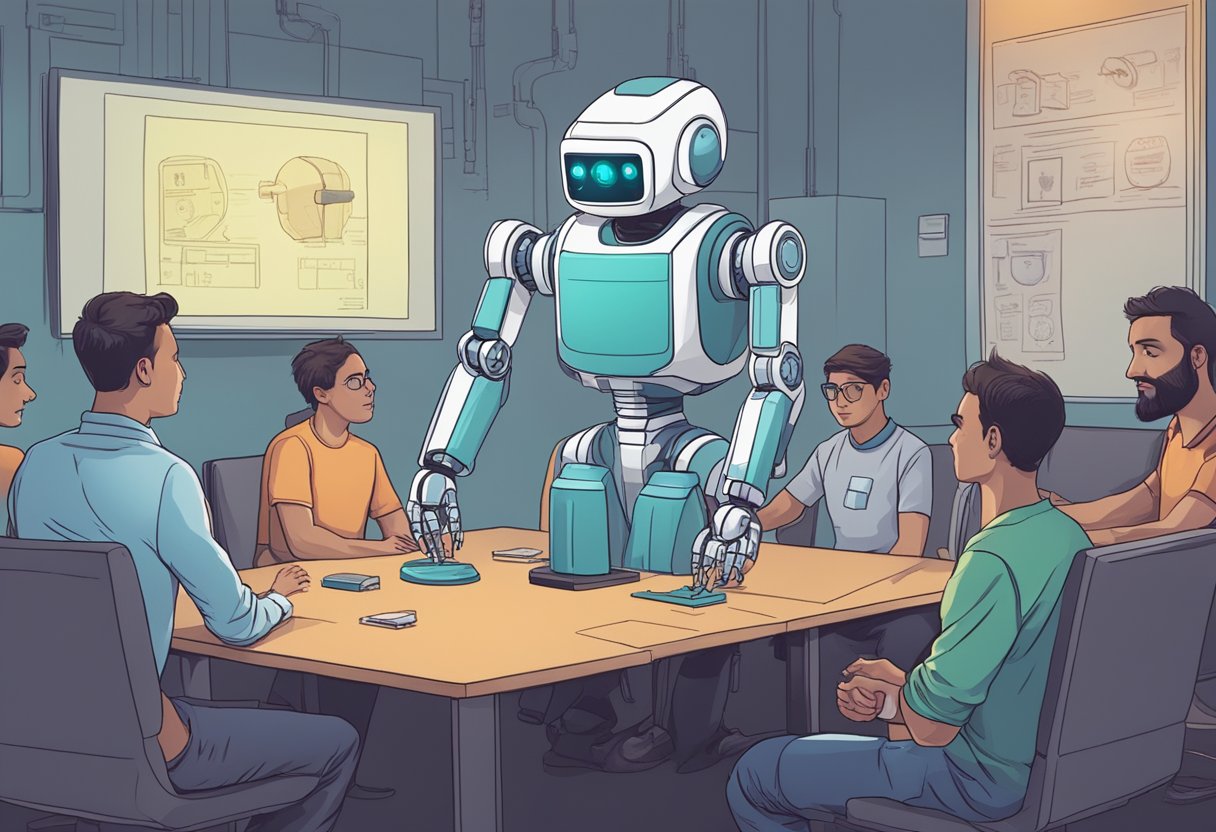AI and machine learning are two terms that are often used interchangeably, but they are not the same thing.
AI, or artificial intelligence, is the broader concept of enabling machines or systems to sense, reason, act, or adapt like humans.
Machine learning, on the other hand, is a subset of AI that allows machines to extract knowledge from data and learn from it autonomously.
The core difference between AI and machine learning is that AI is the broader family consisting of machine learning and deep learning as its components.
Machine learning is the subset of artificial intelligence that enables machines to learn from data and improve their performance over time.
In other words, machine learning is a technique used to achieve artificial intelligence.
AI and machine learning have numerous applications and real-world uses.
AI is used in various industries, such as healthcare, finance, transportation, and education, to improve efficiency and accuracy.
Machine learning is used in data analysis, predictive modeling, natural language processing, and image recognition, among others.
Key Takeaways
- AI is the broader concept of enabling machines or systems to sense, reason, act, or adapt like humans, while machine learning is a subset of AI that allows machines to extract knowledge from data and learn from it autonomously.
- Machine learning is a technique used to achieve artificial intelligence, and it is used in various industries, such as data analysis, predictive modeling, natural language processing, and image recognition, among others.
- AI and machine learning have numerous applications and real-world uses, and they are constantly evolving to meet new challenges and considerations.
Defining AI and Machine Learning
Artificial Intelligence (AI) and Machine Learning (ML) are two of the most popular buzzwords in the field of computer science. These two terms are often used interchangeably, but they are not the same thing.
What is Artificial Intelligence?
Artificial Intelligence (AI) is the process of creating intelligent machines that can perform tasks that would typically require human intelligence to complete.
AI is the ability of a machine to mimic human intelligence and perform tasks like speech recognition, decision-making, and language translation.
AI is a broad field that includes several subfields, such as machine learning, natural language processing, and robotics.
AI has been around for a long time, but it has only recently become more mainstream due to the availability of large amounts of data and the increase in computing power.
Understanding Machine Learning as a Subset of AI
Machine Learning (ML) is a subset of AI that focuses on developing algorithms that can learn from data.
Machine learning algorithms are designed to learn patterns in data and use those patterns to make predictions or decisions.
ML algorithms can be divided into three categories: supervised learning, unsupervised learning, and reinforcement learning.
In supervised learning, the algorithm is trained on labeled data, while in unsupervised learning, the algorithm is trained on unlabeled data. Reinforcement learning involves training an algorithm to make decisions based on feedback received from its environment.
Core Differences Between AI and Machine Learning
Goals and Objectives
Artificial Intelligence (AI) and Machine Learning (ML) are two distinct concepts that are often used interchangeably.
While AI is a broader term that refers to the ability of machines to perform tasks that typically require human intelligence, ML is a subset of AI that involves teaching machines to learn from data and improve their performance over time.
The main goal of AI is to create intelligent machines that can think, reason, and learn like humans, while the primary objective of ML is to develop algorithms and models that can automatically improve their performance based on experience.
Scope of Functionality
Another significant difference between AI and ML is their scope of functionality.
AI is a more comprehensive concept that encompasses a wide range of technologies, including natural language processing, computer vision, robotics, and expert systems.
In contrast, ML is a specific technique that involves training algorithms to learn from data and make predictions or decisions based on that learning.
ML algorithms can be used for a variety of tasks, such as image recognition, speech recognition, and predictive analytics.
Learning and Adaptation
The most fundamental difference between AI and ML is their approach to learning and adaptation.
AI systems are typically programmed with a set of rules or instructions that dictate how they should behave in different situations.
In contrast, ML algorithms are designed to learn from data and improve their performance over time.
This means that ML algorithms can adapt to new situations and make better predictions or decisions based on their past experience.
ML algorithms use a variety of techniques, including supervised learning, unsupervised learning, and reinforcement learning, to learn from data and improve their performance.
Applications and Real-World Uses
AI in Daily Life
Artificial Intelligence (AI) has become an integral part of our daily lives.
It is used in various applications, from voice assistants like Siri and Alexa to recommendation systems on e-commerce websites.
AI is also used in self-driving cars, which are becoming more common on the roads. These cars use sensors and cameras to detect obstacles and make decisions based on the data they receive.
AI is also used in customer service, where chatbots and virtual assistants are used to provide quick and efficient support.
These systems use natural language processing (NLP) to understand and respond to customer queries.
Machine Learning in Industry
Machine Learning (ML) is widely used in industry for various applications.
In banking, ML is used for fraud detection and risk assessment. ML algorithms can analyze large amounts of data and identify patterns that may indicate fraudulent activity.
In manufacturing, ML is used for predictive maintenance, which helps reduce downtime and increase efficiency.
ML algorithms can analyze data from sensors and predict when machines are likely to fail, allowing for maintenance to be scheduled before a breakdown occurs.
In healthcare, ML is used for disease diagnosis and treatment planning.
ML algorithms can analyze medical images and identify abnormalities that may be missed by human doctors.
ML is also used for drug discovery, where algorithms can analyze large amounts of data to identify potential new drugs.
Technological and Methodological Approaches

Algorithms and Models
One of the main differences between AI and machine learning is the approach they take to solve problems.
AI is a broader concept that encompasses a range of technologies and approaches to mimic human intelligence.
On the other hand, machine learning is a subset of AI that uses algorithms trained on data to produce models that can perform complex tasks.
Machine learning algorithms can be supervised, unsupervised, or reinforced, depending on the type of learning required.
These algorithms are designed to learn from data and make predictions or decisions based on that data.
Data Handling and Analysis
Data is a crucial component of both AI and machine learning.
AI systems require large amounts of data to learn and make decisions.
Machine learning algorithms are trained on data sets to produce models that can make predictions or decisions based on that data.
The handling and analysis of data is a critical component of machine learning.
Data can be structured or unstructured, and machine learning algorithms can be designed to handle both types of data.
Big data is a term used to describe large data sets that are too complex for traditional data processing methods.
Machine learning algorithms can be used to analyze big data sets and extract insights from them.
Neural Networks and Deep Learning
Neural networks are a type of machine learning algorithm that is modeled after the structure of the human brain.
Neural networks are designed to learn from data and make predictions or decisions based on that data.
Deep learning is a subset of neural networks that uses multiple layers of artificial neurons to learn from data.
Deep learning algorithms are used in a variety of applications, including image and speech recognition.
Deep learning algorithms require large amounts of data to train the neural networks and produce accurate results.
Challenges and Considerations in AI and Machine Learning

Ethical Implications
As AI and machine learning continue to advance, there are growing concerns about the ethical implications of these technologies.
One of the main concerns is the potential for bias in the algorithms used in AI and machine learning. These biases can be unintentional, but they can lead to discrimination against certain groups of people.
For example, if an algorithm is trained on data that is biased against a certain race or gender, it may produce results that are also biased.
Another ethical concern is the potential for AI and machine learning to replace human workers.
While these technologies can increase efficiency and productivity, they also have the potential to replace jobs that were previously done by humans.
This can have a significant impact on the workforce and the economy as a whole.
Data Privacy and Security
As AI and machine learning rely heavily on data, there are also concerns about data privacy and security.
With large amounts of data being collected and analyzed, there is a risk that this data could be used for malicious purposes.
This is particularly concerning in industries such as healthcare, where sensitive patient data is being analyzed.
In addition, there is also the risk of data breaches and cyber attacks.
As AI and machine learning become more prevalent, the potential for these types of attacks increases.
It is important for organizations to take steps to ensure that their data is secure and protected.
Future of AI and Machine Learning
The future of AI and machine learning is both exciting and uncertain.
While these technologies have the potential to revolutionize many industries, there are also concerns about their impact on society.
It is important for organizations and individuals to consider the ethical implications of these technologies and to take steps to ensure that they are used in a responsible and ethical manner.
Innovation in AI and machine learning is also likely to continue at a rapid pace.
This will require ongoing investment in research and development, as well as collaboration between industry, academia, and government.
As these technologies continue to evolve, it is important for all stakeholders to work together to ensure that they are used in a way that benefits society as a whole.



